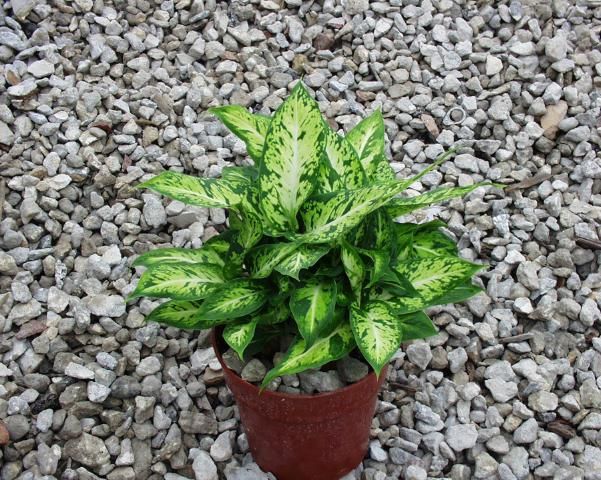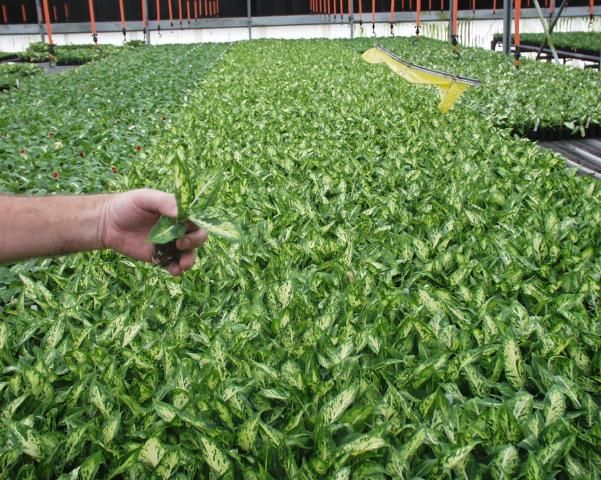Origin
Dieffenbachia are important commercial foliage plants consistently ranking in the top 10 in annual sales. Growers encounter few problems during production, finishing, or shipping since the crop tolerates a wide range of cultural conditions. The attractive variegated leaves appeal to buyers, and the plants easily adapt to interior home or office environments. Several generations of Dieffenbachia breeding have sought to improve leaf color, leaf patterns, branching habit, and interior performance. Dieffenbachia 'Sparkles' is the result of such breeding efforts and has been released from the Foliage Plant Breeding Program at the UF/IFAS Mid-Florida Research and Education Center (MREC) in Apopka.
The dominant feature of Dieffenbachia 'Sparkles' is its bright leaf color (Figure1). There is high contrast between the light green and dark green variegation patterning, which is highlighted by a white midrib. The plant branches freely, producing up to 15 or more side shoots per main stem. Short spacing between the leaves along the stem creates a very compact and full appearance.

Credit: UF/IFAS
Description
The petioles of Dieffenbachia 'Sparkles' are green-white in color and have long, wide wings at the base, giving the plant an appearance of having a ribbed stem. Leaf size averages 20–22 cm (7–8 in.) long and 9–10 cm (4–5 in.) wide. Leaves have a predominantly light green background center color, with random splotches of deep green and irregular blotches of white occurring parallel to the primary veins. This results in an attractive paisley, mottled appearance. The midrib of each leaf appears as a straight, solid, nearly white stripe due to a lack of chlorophyll. Leaves have continuous, deep green margins, and the edges along the leaf lack undulations, resulting in erect, smooth leaves not commonly found in Dieffenbachia varieties. Dieffenbachia 'Sparkles' plants branch freely, producing multiple side shoots per main stem. Each stem has a high density of leaves, and the short spacing between the leaves along each stem causes Dieffenbachia 'Sparkles' to be very compact. 'Sparkles' retains its lower leaves along the stem even with advancing age.
Growth characteristics and performance of Dieffenbachia 'Sparkles' were determined from three greenhouse production trials. Trials were initiated using uniform liners obtained from a commercial tissue-culture laboratory. Thirty 10-week-old liners were potted into 6 in. diameter (1.6 L) plastic pots filled with Vergro Container Mix A. Plants were treated with low, medium, or high rates of Osmocote® 19:6:12 (nitrogen: phosphorus: potassium). Osmocote® was applied at 2.5, 4.2, or 5.9 g per pot (5.5 g = approximately 1 tsp.). Fertilizer was applied when the experiment started and again after 12 weeks. There were 10 replications per fertilizer level. Tests were conducted in a greenhouse shaded to exclude 70% of sunlight, under natural photoperiod, and at a temperature range of 15°C–34°C (59°F–93°F). Plants were grown for 24 weeks, at which time plant height, leaf size, branching, and quality were measured. Data were analyzed using the ANOVA procedures of the SAS program.
Dieffenbachia 'Sparkles' performed well over a range of fertilization rates (Table 1). Plant height, leaf size, and number of basal shoots were not significantly different among the low, medium, and high fertilizer rates. The lack of significant statistical differences in growth rates between the fertilizer levels indicates that 'Sparkles' yields full and compact plants for commercial growers over a wide range of conditions (Figure 2). All plants in this growth test performed well and received an "excellent" rating for visual quality, where 1 = poor, 3 = acceptable (saleable), and 5 = excellent.

Credit: UF/IFAS
After greenhouse testing, Dieffenbachia 'Sparkles' plants were placed in a growth chamber to evaluate their performance in a consumer home or office environment. Plants received light from cool white fluorescent bulbs for 12 hours per day. Plants were evaluated after three months. Quality ratings were excellent. All plants maintained compact growth habit, leaf retention, and good color definition. This cultivar performs exceptionally well in interior environments.
Availability
Dieffenbachia 'Sparkles' is protected under U.S. Plant Patent No. 9050. Commercial foliage plant growers can obtain licensed stock for Dieffenbachia 'Sparkles' through Florida tissue-culture laboratories. Names of cooperating laboratories may be obtained from the Florida Foundation Seed Producers, PO Box 309, Greenwood, FL 32443. The dense branching and compact growth habit of Dieffenbachia 'Sparkles' make it suitable for production in 4 in. diameter (0.5 L) pots or 6 in. diameter (1.6 L) pots.
Additional Information
Henny, R. J., C. A. Conover, and R. T. Poole. 1987. "'Triumph' Dieffenbachia." HortScience 22:965–966.
Henny, R. J., C. A. Conover, and R. T. Poole. 1987. "'Victory' Dieffenbachia." HortScience 22:967–968.
Henny, R. J., R. T. Poole, and C. A. Conover, 1988. "'Tropic Star' Dieffenbachia." HortScience 23:919–920.
Henny, R.J., R.T. Poole, and C.A. Conover, 1989. "'Starry Nights' Dieffenbachia." HortScience 24:522–524.